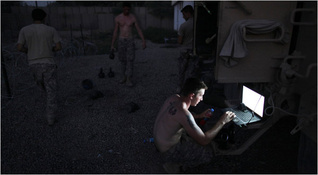
urbansheep@gmail.com
Staying in Touch With Home, for Better or Worse - NYTimes.com - http://www.nytimes.com/2011... (via http://friendfeed.com/technol...)

|

|
17 февраля 2011 в 19:27
Nick Losev
mindszenty
“UNDUZ, Afghanistan — Forget the drones, laser-guided bombs and eye-popping satellite imagery. For the average soldier, the most significant change to modern warfare might just boil down to instant chatting. Consider these scenes from northern Afghanistan: A gunner inside an armored vehicle types furiously on a BlackBerry, so engrossed in text-messaging his girlfriend in the United States that he has forgotten to watch for enemy movement. A medic watches her computer screen with something approaching rapture as her 2-year-old son in Florida scrambles in and out of view before planting wet kisses on the camera lens, 7,500 miles away. A squad leader who has just finished directing gunfire against insurgents finds a quiet place inside his combat outpost, whips out his iPhone and dashes off an instant message to his wife back home. “All is well,” he tells her, adding, “It’s been busy.” The communication gap that once kept troops from staying looped into the joyful, depressing, prosaic or sordid details of home life has all but disappeared. With advances in cellular technology, wider Internet access and the infectious use of social networking sites like Facebook, troops in combat zones can now communicate with home nearly around the clock. They can partake in births and birthdays in real time. They can check sports scores, take online college courses and even manage businesses and stock portfolios. But there is a drawback: they can no longer tune out problems like faulty dishwashers and unpaid electric bills, wayward children and failing relationships, as they once could.” - × × ×
© 2015 FriendFeed (and Clio archiver)